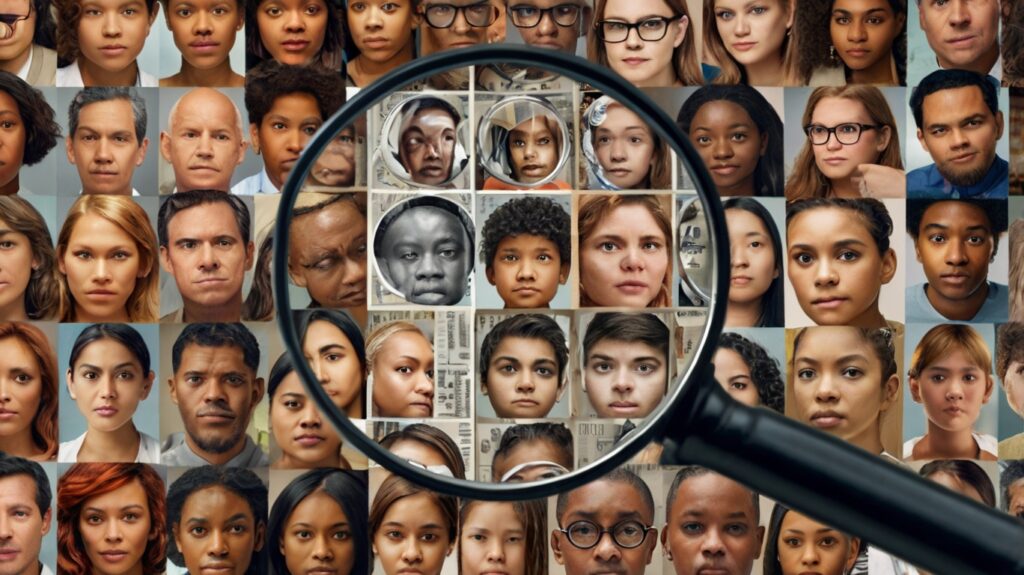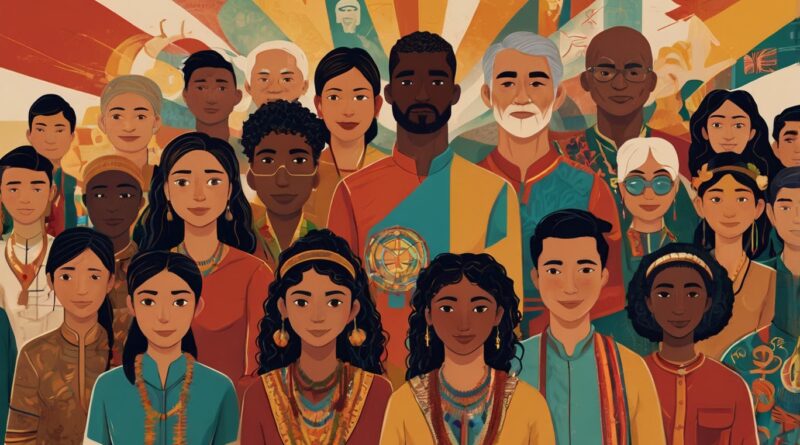Understanding the Distinction: Exploring the Difference between Race and Ethnicity
As human beings, we often use the terms “race” and “ethnicity” interchangeably. However, it’s important to understand that these two concepts have distinct meanings and implications. In this article, we will delve into the difference between race and ethnicity, unraveling their complexities and shedding light on their social and cultural impacts.
Race refers to a social construct that categorizes people based on physical characteristics such as skin color, hair texture, and facial features. It is often used to classify individuals into broad groups such as White, Black, Asian, or Indigenous. On the other hand, ethnicity relates to a shared cultural heritage, including traditions, language, ancestry, and customs.
By gaining a clear understanding of the distinction between race and ethnicity, we can recognize the diversity within each group and eliminate stereotypes and prejudices. Moreover, comprehending these concepts enables us to appreciate the richness of different cultures and enhances our ability to foster inclusivity and equality.
So join us on this insightful journey as we explore the difference between race and ethnicity, challenging our preconceived notions and promoting a more inclusive society. Remember, knowledge is the key to understanding and embracing diversity.
Defining Race and Ethnicity
To understand the distinction between race and ethnicity, we first need to define each term clearly. Race is primarily understood as a classification based on physical characteristics, including skin color, hair texture, and facial features. These traits are often used to categorize individuals into broad groups such as White, Black, Asian, or Indigenous. The concept of race has been historically tied to the idea of biological differences, though contemporary understanding emphasizes that these categories are socially constructed rather than scientifically grounded.

Ethnicity, on the other hand, refers to shared cultural traits and a sense of belonging to a particular group. It encompasses aspects such as language, religion, customs, and traditions that are passed down through generations. Individuals who identify with a specific ethnicity often share a common heritage and cultural practices that differentiate them from others. Ethnicity is more about cultural identity than physical appearance, emphasizing the social and cultural bonds that unite individuals.
In summary, while race is often associated with observable physical characteristics, ethnicity involves shared cultural experiences and identity. Recognizing this distinction is crucial for respectful dialogue about identity, as it allows us to appreciate the complexities of human diversity beyond mere physical traits. Understanding these definitions lays the groundwork for deeper exploration into the historical and social contexts that shape our perceptions of race and ethnicity.
Historical Context of Race and Ethnicity
The historical context surrounding race and ethnicity reveals how these concepts have evolved over time and how they have been influenced by socio-political factors. The categorization of people into racial groups can be traced back to the colonial era when European powers sought to justify their dominance over other populations. Racial hierarchies were established, often portraying non-European groups as inferior. This laid the groundwork for systemic racism, which continues to impact societies today.

Ethnicity, in contrast, has been shaped by migration, colonization, and the intermingling of different cultures. Throughout history, groups have moved across borders, leading to the blending of customs, languages, and traditions. For instance, the migration of various ethnic groups to the Americas created a rich tapestry of cultural identities, from Native American tribes to Latino communities. These interactions have fostered new ethnic identities while also contributing to the preservation of distinct cultural heritages.
In modern times, both race and ethnicity continue to play significant roles in shaping social dynamics. Movements advocating for civil rights and social justice have highlighted the need to confront racial discrimination and promote ethnic pride. Understanding the historical context of these concepts is essential for recognizing how past injustices inform contemporary discussions about identity, equality, and social cohesion. It invites us to engage critically with our shared history and its implications for current societal structures.
Understanding the Social Construction of Race and Ethnicity
The notion that race and ethnicity are socially constructed rather than biologically determined is essential for grasping their implications in today’s world. The social construction of race suggests that society creates and assigns meaning to physical differences, leading to the formation of racial categories. These categories can shift over time and vary across different cultures. For example, the definition of who is considered “Black” or “White” has changed throughout American history, influenced by social, political, and economic factors.

Similarly, ethnicity is constructed through shared cultural practices and experiences. While racial categories often focus on surface-level characteristics, ethnicity encompasses a broader range of identifiers, such as language, traditions, and shared history. Ethnic identities can be fluid; individuals may identify with multiple ethnicities or redefine their ethnic identity over time, depending on their environment and experiences. This fluidity challenges static notions of identity, encouraging a more nuanced understanding of how individuals navigate their cultural landscapes.
In essence, both race and ethnicity are shaped by societal norms and historical contexts, emphasizing the importance of viewing them as dynamic concepts. Recognizing their social construction allows us to question stereotypes and prejudices that stem from rigid definitions. It also encourages a more inclusive perspective on identity, where individuals are seen as complex beings shaped by multiple cultural influences rather than confined to narrow categories.
Exploring the Similarities and Differences between Race and Ethnicity
While race and ethnicity are often conflated, they possess both similarities and differences that merit exploration. One of the primary similarities is that both concepts serve as frameworks for understanding human diversity. They help categorize individuals into groups, providing a sense of identity and belonging. Both race and ethnicity can influence personal and collective experiences, shaping how individuals perceive themselves and are perceived by others.
Despite these similarities, the core differences lie in their foundations and implications. Race is primarily based on physical characteristics, often leading to the assumption of inherent differences among groups. This biological perspective can contribute to harmful stereotypes and discrimination. In contrast, ethnicity is rooted in cultural identity, focusing on shared traditions and experiences. Ethnic groups may share similar backgrounds yet differ significantly in their cultural practices, languages, and beliefs.
Furthermore, the implications of race often extend to systemic issues such as institutional racism, while ethnicity tends to emphasize cultural pride and community solidarity. Understanding these distinctions is vital for addressing social injustices and fostering a more inclusive society. By appreciating the complexities of race and ethnicity, we can move beyond simplistic categorizations and engage in meaningful discussions about identity, culture, and the shared human experience.
The Impact of Race and Ethnicity on Identity and Culture
Race and ethnicity significantly shape individual and collective identities, influencing how people perceive themselves and how they relate to others. For many, race can be a predominant aspect of their identity, impacting their experiences in various social contexts. Racial identity often intersects with other facets of a person’s identity, such as gender, socioeconomic status, and geographic location, creating a unique tapestry of experiences that informs their worldview and self-perception.

Ethnicity plays an equally crucial role in identity formation, as it encompasses shared cultural practices, traditions, and values. Individuals who identify strongly with their ethnic group often find a sense of belonging and community. This shared identity fosters connections through cultural events, language, and rituals, enriching personal and collective experiences. Ethnic identity can also serve as a source of resilience, allowing individuals to navigate challenges while drawing strength from their cultural heritage.
Moreover, both race and ethnicity influence broader cultural dynamics, shaping societal norms, values, and practices. They inform the arts, literature, cuisine, and social customs, contributing to the rich diversity of human expression. Understanding the impact of race and ethnicity on identity and culture is essential for promoting empathy and respect among individuals from different backgrounds. By acknowledging the significance of these concepts, we can foster a deeper appreciation for the complexities of human identity and the diverse cultures that enrich our world.
Addressing Misconceptions and Stereotypes Surrounding Race and Ethnicity
Misconceptions and stereotypes surrounding race and ethnicity often perpetuate discrimination and social division. One common misconception is the belief that racial categories are fixed and scientifically valid. In reality, race is a social construct that lacks a biological basis. The oversimplification of racial groups leads to harmful stereotypes, such as the notion that certain races possess inherent traits or abilities. These stereotypes not only dehumanize individuals but also contribute to systemic inequalities in various domains, including education, employment, and healthcare.

Similarly, misconceptions about ethnicity can lead to cultural appropriation and misunderstanding. Individuals may assume a monolithic view of ethnic groups, ignoring the rich diversity and internal variations that exist within them. For instance, the term “Asian” encompasses a vast array of cultures, languages, and traditions, yet it is often used as a blanket label. Such generalizations can result in the erasure of unique cultural identities and practices, perpetuating stereotypes and biases.
To combat these misconceptions, it is essential to promote education and awareness around the complexities of race and ethnicity. Encouraging open dialogue and critical reflection can help dismantle stereotypes and foster a more nuanced understanding of identity. By challenging preconceived notions and embracing the diversity within and among racial and ethnic groups, we can work towards a more inclusive society that values individual experiences and cultural heritage.
The Importance of Acknowledging and Respecting Diversity
Acknowledging and respecting diversity is crucial in fostering a society that values inclusivity and equality. Recognizing the distinctions between race and ethnicity allows us to appreciate the rich tapestry of human experiences that shape our world. When we celebrate diversity, we create an environment where individuals feel seen, heard, and valued for who they are, rather than being reduced to stereotypes or assumptions based on their race or ethnicity.

Respecting diversity involves actively listening to and learning from individuals from different backgrounds. It requires an openness to understanding unique cultural practices, traditions, and perspectives. By engaging with diverse communities and promoting intercultural dialogue, we can break down barriers and foster connections that transcend racial and ethnic divides. This not only enriches our personal lives but also strengthens the social fabric of our communities.
Moreover, acknowledging diversity is essential for addressing systemic inequalities and promoting social justice. It allows us to recognize the historical and contemporary struggles faced by marginalized groups, empowering us to advocate for change. By creating spaces that celebrate diversity and challenge biases, we can work towards dismantling the structures that perpetuate discrimination and inequality. In doing so, we contribute to building a more equitable and just society for all.
Promoting Inclusivity and Equality in Society
Promoting inclusivity and equality requires deliberate efforts to address the disparities and biases that exist within our societies. This begins with recognizing the importance of representation across all sectors, including education, media, politics, and the workplace. Diverse representation ensures that a variety of voices and perspectives are heard, contributing to more equitable decision-making processes and policies. When individuals from different racial and ethnic backgrounds are included, it enriches discussions and fosters innovation.
Education plays a crucial role in promoting inclusivity. By incorporating diverse perspectives into curricula, we can challenge stereotypes and foster understanding among students from an early age. Teaching the histories and contributions of various racial and ethnic groups can help dismantle prejudices and encourage empathy. Additionally, creating safe spaces for open dialogue about race and ethnicity allows individuals to share their experiences and learn from one another.
Community engagement is another vital aspect of promoting inclusivity. Initiatives that bring together individuals from diverse backgrounds can foster collaboration and understanding. Organizing cultural events, workshops, and discussions that celebrate differences while highlighting commonalities can strengthen community bonds. By actively working towards inclusivity and equality, we contribute to a society where everyone can thrive, regardless of their racial or ethnic identity.
Conclusion: Embracing the Complexities of Race and Ethnicity
In conclusion, understanding the distinction between race and ethnicity is essential for fostering a more inclusive and equitable society. By recognizing that race is a social construct based on physical characteristics and that ethnicity encompasses shared cultural traits, we can appreciate the richness of human diversity. Addressing misconceptions and stereotypes surrounding these concepts allows us to engage in more meaningful conversations about identity and cultural heritage.
Embracing the complexities of race and ethnicity invites us to challenge our preconceived notions and actively promote respect for diverse backgrounds. It encourages us to listen to the experiences of others and acknowledge the historical contexts that shape contemporary social dynamics. By fostering inclusivity and equality, we can work towards a society where every individual is valued for their unique identity and contributions.
Ultimately, the journey to understanding race and ethnicity is ongoing. It requires continuous learning, empathy, and a commitment to social justice. By engaging with these concepts thoughtfully, we can contribute to a more harmonious world that celebrates the beauty of diversity and the shared human experience.

